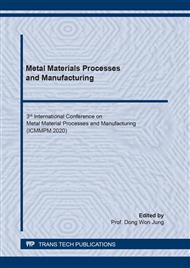[1]
N. K. Jain, V. K. Jain, S. Jha, Parametric optimization of advanced fine-finishing processes, Int. J. Adv. Manuf. Technol. 34 (2007) 1191–1213.
DOI: 10.1007/s00170-006-0682-4
Google Scholar
[2]
A. Misra, P. M. Pandey, U. S. Dixit, A. Roy, et al. Multi-objective optimization of ultrasonic-assisted magnetic abrasive finishing process, Int. J. Adv. Manuf. Technol. 101 (2019) 1661–1670.
DOI: 10.1007/s00170-018-3060-0
Google Scholar
[3]
T. W. Kim, J. S. Kwak, A study on deburring of magnesium alloy plate by magnetic abrasive polishing, Int. J. Precis. Eng. Man. 11(2) (2010) 189-194.
DOI: 10.1007/s12541-010-0021-4
Google Scholar
[4]
K. Tsuchiya, Y. Shimizu, K. Sakaki, M. Sato, Polislling Mechanism of Magnetic Abrasion, J. Japan Inst. Metals (Japan), 57(11) (1993) 1333-1338.
DOI: 10.2320/jinstmet1952.57.11_1333
Google Scholar
[5]
P. Jayakumar, S. Ray, V. Radhakrishnan, Optimising progress parameters of magnetic abrasive machining to reduce the surface roughness value, Journal of spacecraft technology, 7(1) (1997) 58-64.
Google Scholar
[6]
T. Shinmura, K. Takazawa, E. Hatano, Study on magnetic abrasive process -Application to plane finishing-, Bull. Jpn. Soc. Precis. Eng. 19(4) (1985) 289-294.
Google Scholar
[7]
T. Shinmura, K. Takazawa, Study on magnetic abrasive finishing -characteristics of finished surface-, Bull. Jpn. Soc. Precis. Eng. 53(11) (1987)1791-1793.
Google Scholar
[8]
J. Kang, A. George, H. Yamaguchi, High-speed Internal Finishing of Capillary Tubes by Magnetic Abrasive Finishing, Procedia CIRP, 1 (2012) 414-418.
DOI: 10.1016/j.procir.2012.04.074
Google Scholar
[9]
R. S. Mulik, P.M. Pandey, Ultrasonic assisted magnetic abrasive finishing of hardened AISI 52100 steel using unbonded SiC abrasives, Int. J. Refract. Met. Hard Mater. 29(1) (2011) 68–77.
DOI: 10.1016/j.ijrmhm.2010.08.002
Google Scholar
[10]
V. K. Jain, P. Kumar, P. K. Behera, S. C. Jayaswal, Effect of working gap and circumferential speed on the performance of magnetic abrasive finishing process, Wear 250(1-12) (2001) 384-390.
DOI: 10.1016/s0043-1648(01)00642-1
Google Scholar
[11]
A. Y. Jiao, H. J. Quan, Z. Z. Li, Y. H. Zou, Study on improving the trajectory to elevate the surface quality of plane magnetic abrasive finishing, Int. J. Adv. Manuf. Technol. 80(9-12) (2015) 1613-1623.
DOI: 10.1007/s00170-015-7136-9
Google Scholar
[12]
Y. H. Zou, A. Y. Jiao, T. Aizawa, Study on Plane Magnetic Abrasive Finishing Process - Experimental and Theoretical Analysis on Polishing Trajectory -, Advanced Materials Research 126 (2010) 1023-1028.
DOI: 10.4028/www.scientific.net/amr.126-128.1023
Google Scholar
[13]
Y. H. Zou, T. Shinmura, F. Wang. Study on a Magnetic Deburring Method by the Application of the Plane Magnetic Abrasive Machining Process, Advanced materials research 76 (2009) 276-281.
DOI: 10.4028/www.scientific.net/amr.76-78.276
Google Scholar


